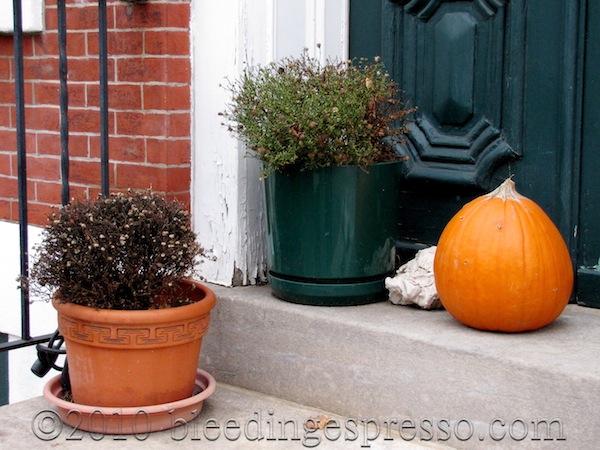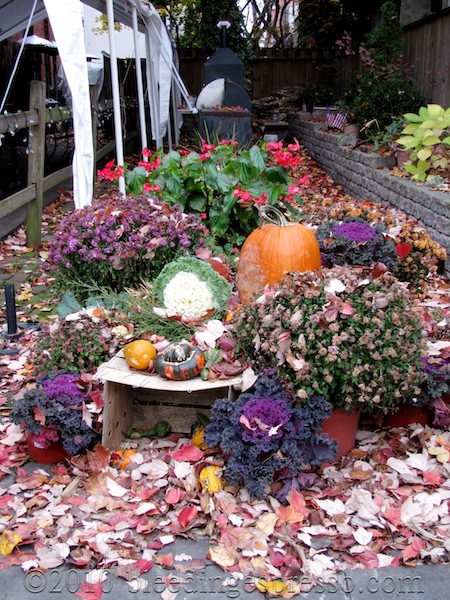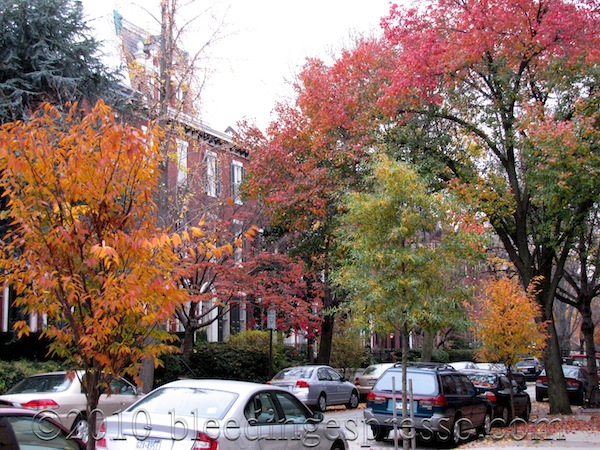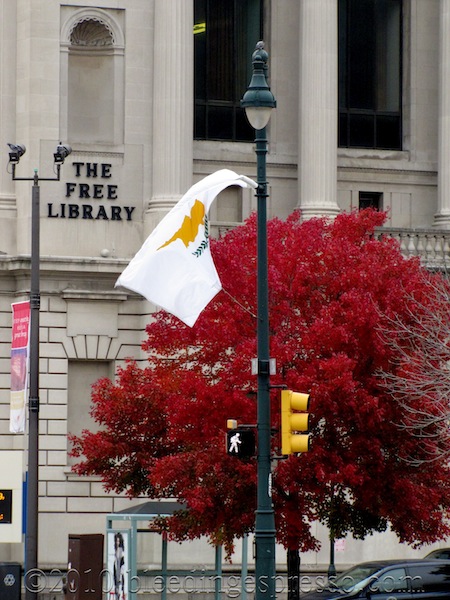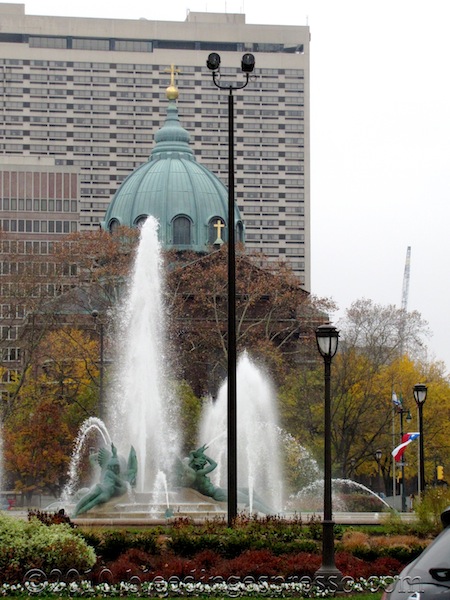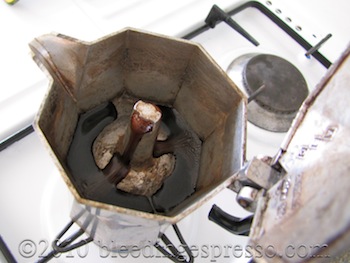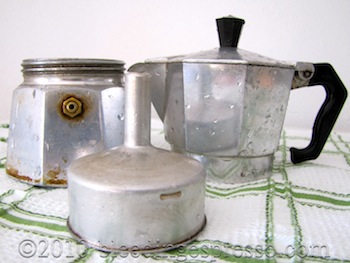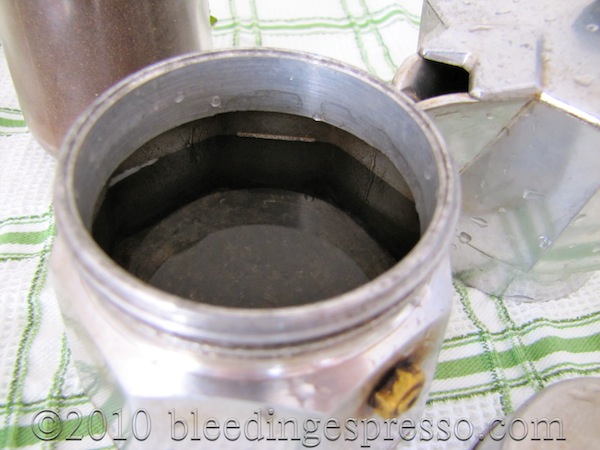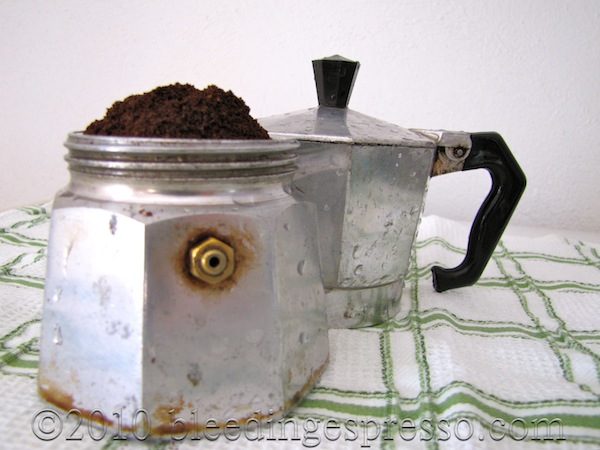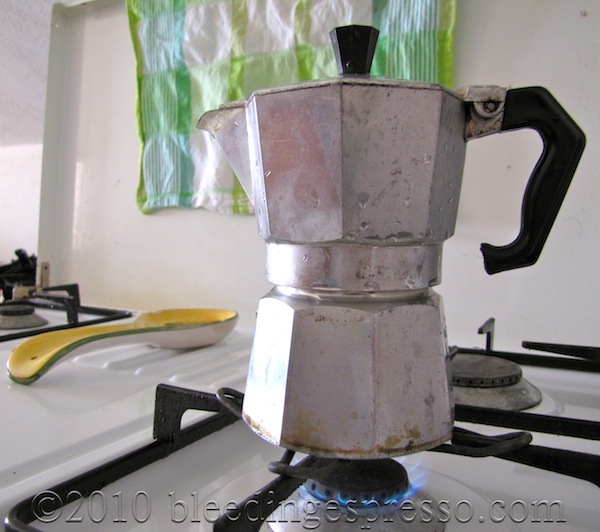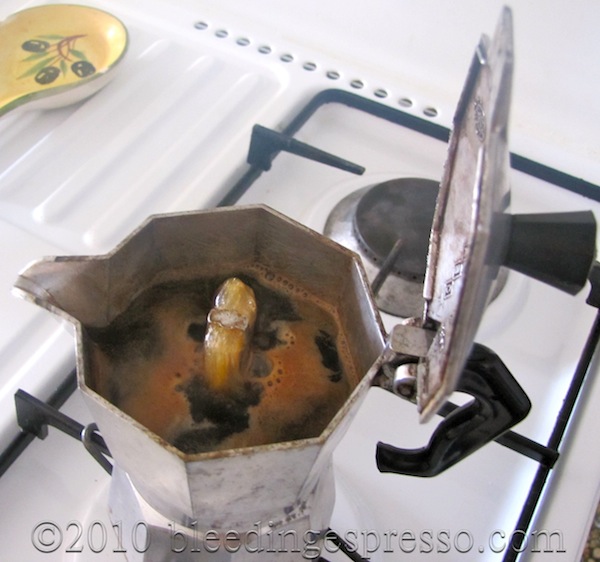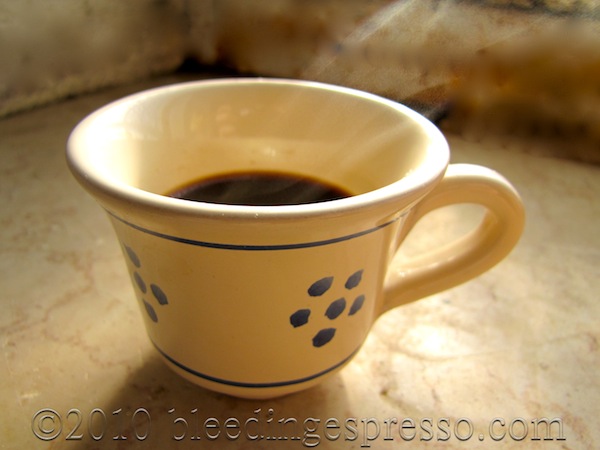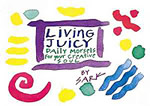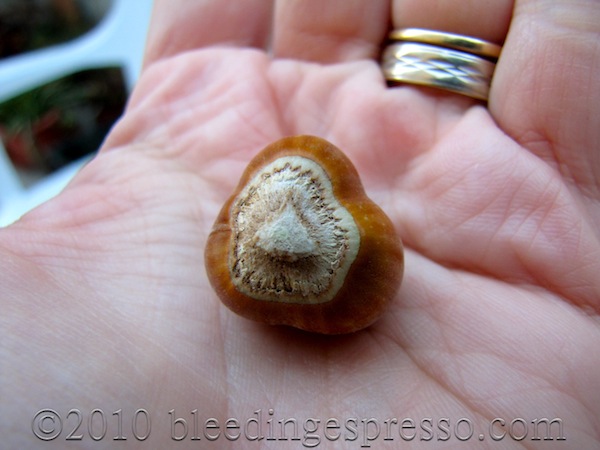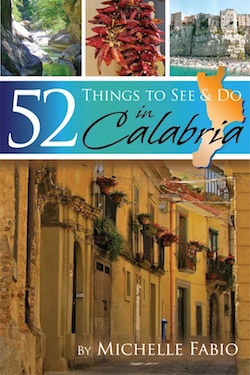Archive for 2010
Fall in Philadelphia: Happy Thanksgiving!
Last year at this time, I was in Pennsylvania having Thanksgiving with my family. This year, I’m going to be spending the long weekend in northern Italy with Sara (Ms Adventures in Italy), Diana (A Certain Simplicity and Piemontescapes), and hopefully others I’ve only known virtually until now, but today with last year on my mind, I’d like to share some fall in Philadelphia shots from last November.
These are all taken in the Art Museum/Ben Franklin Parkway area — the area I lived in for five years:
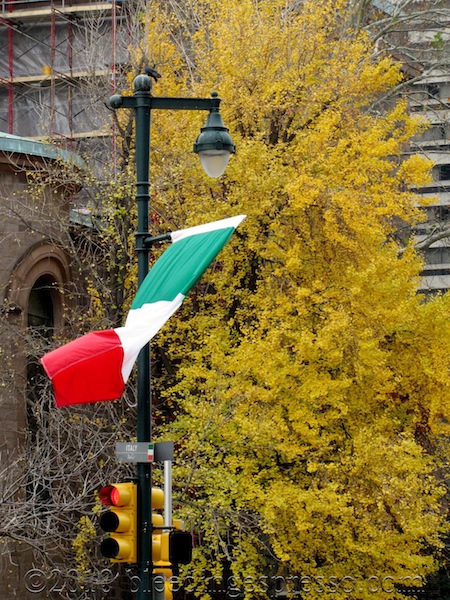
Italy's flag on the Ben Franklin Parkway; the rest are in alphabetical order, but Italy's is placed specially so it's adjacent to the Cathedral.
Happy Thanksgiving!
How are you celebrating Thanksgiving this year?
How to Brew Coffee in a Stovetop Moka Pot
Happy National Espresso Day! While the “National” refers to the US (apparently Italy celebrates espresso in April), I say we make it International Espresso Day — and I’m going to help you celebrate by finally doing the post I know some of you have been waiting to see at Bleeding Espresso:
How to Brew Coffee in a Stovetop Moka Pot
First things first. The word “espresso” refers to the way coffee is brewed not to the coffee itself. Espresso is brewed by water that is forced up threw finely ground coffee because of steam pressure; in America especially, “coffee” is generally made in a percolator or via the drip method. The latter actually ends up having a higher concentration of caffeine, while the former tends to be thicker and richer in flavor.
Put another way, espresso is always coffee, but coffee is not always espresso. That said, it is important that if you want to make espresso in a moka pot, you get finely ground (often called “espresso grind”) coffee as other types are too coarse.
Some people might argue that coffee made in a stovetop moka isn’t *really* espresso since it doesn’t tend to create the gorgeous layer of golden brown “crema” on top, but really since it is indeed brewed via pressure coming up from the bottom, it is.
It’s not going to taste exactly like what you get in a bar (remember in Italy, the place where you get coffee is called the “bar”), but quite simply, for many of us in Italy and elsewhere, making this type of coffee at home is just the most cost effective choice — we also find it quite delicious as well.
Where did the moka pot come from?
The moka pot was created by Bialetti and rose to popularity in Italy in the 1930s; the basic design has been copied ever since, and there are also different moka pot looks, so feel free to experiment. Moka pots also come in different cup sizes (ahem), so it’s not uncommon to see several different sizes of moka pots in an Italian house for use with different numbers of guests.
Now, finally, the easy peasy directions for how to brew coffee in a stovetop moka pot:
1. Fill the bottom with fresh, cold water up to the middle of the safety valve; as you can see in this photo, my moka has a line that marks that level in various places around the bottom, which makes it even easier to tell where to fill to.
2. Put the basket in the bottom, and spoon in the coffee. This part you can experiment with, depending on how strong you like your coffee. As you can see, we like ours pretty strong, but you can fill yours considerably less — the most important thing to remember is not to pack it down.
3. Screw the top onto the bottom creating a super-tight seal. I use a towel for extra traction to really get that last turn tight. Then put the pot on the stove on low heat.
4. The top part of the moka will begin to fill with coffee. When you start to hear the sputter and gurgle of the coffee, remove it from the heat. P.S. Don’t lift the lid as I did for the sake of photos. There is very hot coffee spurting out of there, and it doesn’t care what’s in its way.
5. Serve hot, with or without sugar, with or without steamed milk, just however you like it.
When cleaning the moka, I have been told to never use any kind of detergent on it at all, so I don’t (just hot water and my hands). I have seen recommendations online to use a mild detergent, but I’m going to stick with what the locals here tell me. I do, however, take a scouring pad to my moka pot now and again to keep it looking mildly shiny, but as you can see from the photos, mine isn’t exactly new.
Ah, and that’s another thing about using a moka pot — throw out at least the first batch of coffee made by it, possibly even two or three batches. The flavor is just going to keep getting better the more you use it, so if your pot starts experiencing problems (the coffee is leaking out the sides at the seal or the top part isn’t filling up with coffee), I’d say to change the rubber ring that creates the seal. The replacement ring costs 15 cents (here at least), and it’s well worth a try before you start over with a new moka pot IMHO.
How do you drink your espresso?
Escarole, Bean, and Pancetta Soup – Zuppa di Scarola, Fagioli e Pancetta
Last week Vince at Scordo posted a recipe for Escarole and Bean Soup. It looked tasty to me, and just as I was tucking it away in my memory, wouldn’t you know my mother-in-law gave us a bunch of escarole the next day?
I more or less stuck to Vince’s basic recipe but added some pancetta — and then P wanted some soup pasta with it so we threw that in as well (although that’s not in the photo below).
This recipe is super easy and delicious, especially if you use canned beans. As Vince mentions, your own soaked beans inevitably taste better and are less expensive, though, so give them a try sometime as well.
Overall, I have to say, if you’re looking for a hearty, warm-your-soul kind of meal, this is a wonderful choice.
Escarole, Bean, and Pancetta Soup — Zuppa di Scarola, Fagioli e Pancetta
- 3 tablespoons of olive oil
- 2 cloves of garlic, each cut in half
- 1 peperoncino, cut into a few pieces
- 40 g of pancetta, cubed
- Bunch of escarole, washed and coarsely chopped
- 2 cans of cannellini beans
- 1 liter of water
- Salt to taste
1. Heat olive oil on medium heat in a large soup pot and sautée garlic, peperoncino, and pancetta for a few minutes.
2. Add escarole and sautée until wilted, being sure to coat thoroughly with the oil mixture. Add a bit of salt as well.
3. Add water, beans, and a bit more salt. Cover, turn down heat to low, and let simmer until the escarole is done to your liking — at least 10 to 15 minutes.
4. Serve hot with fresh chunky bread; although it’s not very Italian of me, a slab of butter on the bread and then dipped in the soup just makes everything right with the world.
Buon appetito!
SARK’s Big Purple Dream Crayon *Free* Teleclass
Lately I’ve been delving further into the concepts of inspiration and simplicity. Reading posts at places like Leo Babauta’s Zen Habits, Chris Guillebeau’s The Art of Non-Conformity (as well as his fabulous new book by the same name), and my dear friend Diana’s a certain simplicity*, I’ve come to realize that I’ve been moving in this direction for a long time — at least seven years, in fact, since when I left behind a budding legal career and moved to rural Italy.
But really it dates back even farther than that to when I saw a book by SARK laying around the dorm room of one of my college friends. I’m fairly certain my path to a non-traditional lifestyle (for lack of a better term) started the moment I picked up Living Juicy: Daily Morsels for Your Creative Soul. I still refer to it and other SARK books frequently.
Have you heard of SARK? To me, her books and writings are like candy — they are sweet, give me a jolt to get moving, and always leave me wanting more. And in fact, I see a lot of SARK in the recent surge of websites about simple, non-conformist living; SARK was a true pioneer of this movement IMHO.
But if you don’t know SARK, how can I explain the wonder that is Susan Ariel Rainbow Kennedy? From her Facebook page, she “has been a transformative teacher and leader for over twenty years. She has written and created 16 best-selling books, and hundreds of products. She is the founder and Creative Fountain of Planet SARK, her company that creates products and services to support empowered living.”
Why am I telling you about this now? Well because tomorrow SARK is offering a *free* dream activating teleclass called SARK’s Big Purple Dream Crayon intended to help everyone with a dream reset their dream vibration. This class will provide joyful and practical tools for naming and claiming your dream. It’s free to everyone with a dream, especially if you’re not sure what your dream is:
I’ve already signed up to receive a free recording of the teleclass as it will take place in the middle of the night my time — so if you don’t happen to be available at the time of the teleclass, this is a great option for you as well.
Aside from the teleclass, I also wanted to let you know that I’m looking forward to writing more about my journey toward simplicity and happiness, exploring where I’ve come from, where I am, and where I’m going; I hope you’ll come along with me and even be inspired to make positive changes and chase your dreams along the way as well.
I haven’t decided yet, though, whether Bleeding Espresso is the best forum for this, mixed in with other usual posts about simple life in southern Italy including recipes and finding joy in small things, or whether it would be better served in a new home, on a (*gulp*) new site . . . what do you think?
And what is inspiring you these days?
Love Thursday: An Adorable Little Nuccihra of Love
P and I don’t have grand birthday or Christmas celebrations; neither of us are fans of giving gifts only because it’s expected, although “just because” or “I was thinking of you” tokens are always welcome around here.
And we do tend to exchange little, thoughtful things year round — often simple gestures like one of us taking over cooking duties or running to the store when the other is exhausted. There are some physical gifts, but they tend to be of very little monetary value. In our house, it truly is the thought that counts — it always warms my heart to know that when P was “in giro” (out and about), he saw something and thought of me.
Over the years, he’s brought home tiny rosebuds, almond blossoms, old lire coins, a big bluish green lizard (!), porcini mushrooms, and even some saffron flowers.
And most recently this little nuccihra (noo-CHEE-ruh) arrived:
It’s a type of hazelnut (nocciola) here in the mountains of Calabria —“nuccihra” is Badolatese (local dialect) for little hazelnut . . . an adorable little nuccihra of love if you ask me.
Happy Love Thursday!

